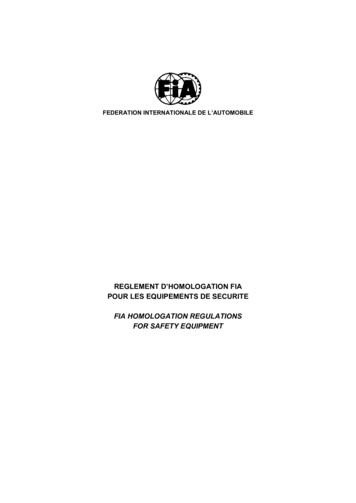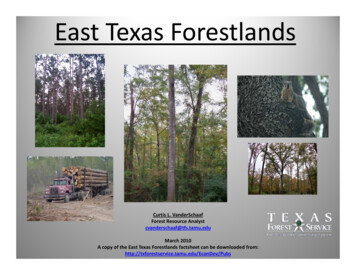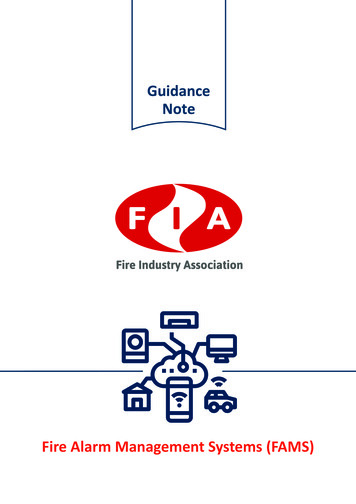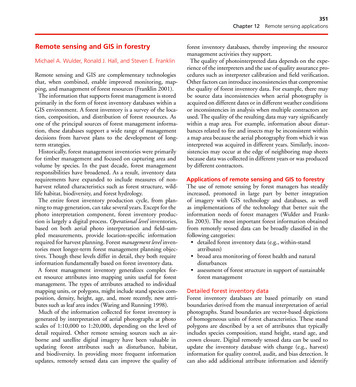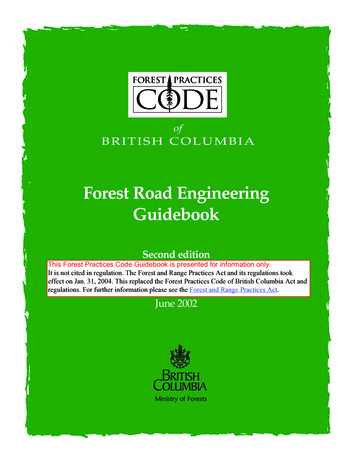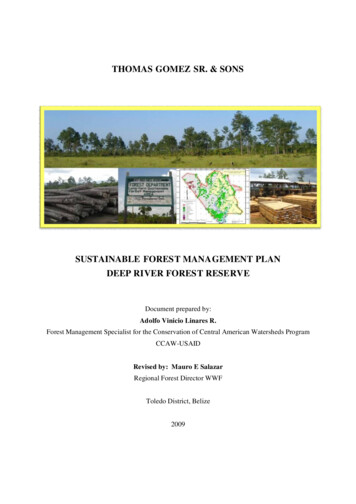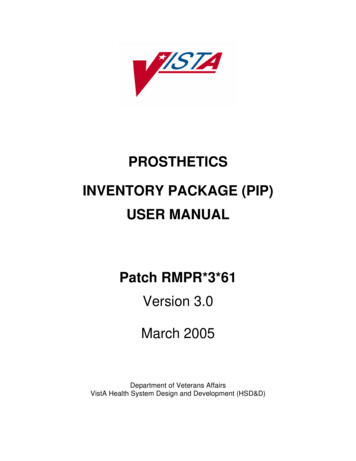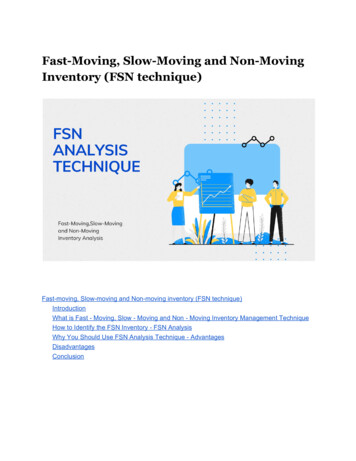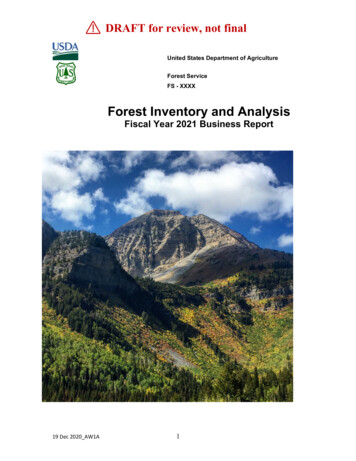
Transcription
DRAFT for review, not finalplacesUnited States Department of AgricultureForest ServiceFS - XXXXForest Inventory and AnalysisFiscal Year 2021 Business Report19 Dec 2020 AW1A1
DRAFT for review, not finalDisclaimerIn accordance with Federal civil rights law and U.S. Department of Agriculture (USDA) civil rightsregulations and policies, the USDA, its Agencies, offices, and employees, and institutions participating inor administering USDA programs are prohibited from discriminating based on race, color, national origin,religion, sex, gender identity (including gender expression), sexual orientation, disability, age, maritalstatus, family/parental status, income derived from a public assistance program, political beliefs, orreprisal or retaliation for prior civil rights activity, in any program or activity conducted or funded by USDA(not all bases apply to all programs). Remedies and complaint filing deadlines vary by program or incident.Persons with disabilities who require alternative means of communication for program information (e.g.,Braille, large print, audiotape, American Sign Language, etc.) should contact the responsible Agency orUSDA’s TARGET Center at (202) 720-2600 (voice and TTY) or contact USDA through the Federal RelayService at (800) 877-8339. Additionally, program information may be made available in languages otherthan English.To file a program discrimination complaint, complete the USDA Program Discrimination Complaint Form,AD-3027, found online at http://www.ascr.usda.gov/complaint filing cust.html and at any USDA office orwrite a letter addressed to USDA and provide in the letter all of the information requested in the form. Torequest a copy of the complaint form, call (866) 632-9992. Submit your completed form or letter to USDAby: (1) mail: U.S. Department of Agriculture, Office of the Assistant Secretary for Civil Rights, 1400Independence Avenue, SW, Washington, D.C. 20250-9410; (2) fax: (202) 690-7442; or (3)email: program.intake@usda.gov.USDA is an equal opportunity provider, employer, and lender.19 Dec 2020 AW1A2
DRAFT for review, not finalForest Inventory and AnalysisFiscal Year 2021 Business ReportPrepared byMila Alvarez, Forest Service Research and Development,Forest Inventory and Analysis, Washington, DCCover photo: Mount Timpanogos, Uinta-Wasatch-Cache National Forest, Utah (2021). Photo courtesy ofBrett Wilson, Scientist, Rocky Mountain Research Station, FIA.19 Dec 2020 AW1A3
ContentsExecutive SummaryIntroductionChanges from Previous Years’ Business ReportsFiscal Year 2021 Program OverviewOutputs and ProductsProgram ResourcesFIA Investment in Partnerships and Partners’ ContributionsFIA Data AvailabilityQuality AssuranceFIA Data Requests and Access for FY 2021Spatial Data ServicesWeb Tools and UseConsultations by FIA StaffFIA Program Accomplishment Highlights for FY 2021Publication of the first forest resource report for the Tanana Unit in Interior AlaskaProcessing forest inventory data at 182 million pixels per secondUsing FIA Data to Understand Habitat Requirements of a Declining Bird SpeciesUsing forest inventory plots to improve remotely sensed burn severity assessmentsMonitoring Forest Dynamics in Real TimeA 15-year partnership: The LANDFIRE and FIA ProgramsA web-based tool for custom small area estimation and mapping of forest inventorydataCarbon Dashboard for the National Forest SystemFire and fungi and bugs, oh my!Urban Forests Count in MissouriCollaboration between Micronesia Conservation Trust and FIA to measure success ofMicronesia ChallengeManaging the FIA Program nationallyFIA Program Area Updates for FY 2021Interior Alaska InventorySmall Area EstimationCarbon Accounting and ReportingLand Use and Land Cover ChangeEcosystem Health IndicatorsUrban Inventoryi-Tree4
Forest Products MonitoringNational Woodland Owner SurveyNational Inventory and Monitoring Applications CenterDigital EngagementCommunity EngagementSpanning CulturesProgram Safety and Annual HighlightsFiscal Year 2022 Anticipated FIA Program DirectionLong-Term Strategic DirectionConclusionsGlossary of Terms Used in AppendixesAppendix A. ContactsAppendix B. Tables5
List of Figures and TablesFigure 1.Figure 2.Figure 3.Figure 4.Figure 5.Figure 6.Figure 7.Figure 8.Figure 9.Figure 10.Figure 11.Figure 12.Figure 13.Figure 14Figure 15Figure 16Figure 17Figure 18.Figure 19Figure 20Figure 20Figure 21.Figure 22.Figure 23.Figure 24.FIA inventory implementation status, FY 2021.FIA Program available funds and expenses by category, FY 2021.FIA-appropriated funding level, FYs 2007–2021.Federal and State FIA program employees by job group, FY 2021.Grants and agreements by recipient group, FY 2021.Grants and agreements to State partners, in thousand dollars, FY 2021.FIA investment in external partnerships through grants and agreements, 1999–2021.Partner contributions by FIA region and type, FY 2021.Total State agency contributions to the FIA program, in thousand dollars, FY 2021.Latest year of availability of online FIA data, FY 2021.Inventory year of FIA State reports, FY 2021.Publication year of FIA State reports, FY 2021.Spatial Data Requests made to the FIA Spatial Data Services Center, FY 2021.Total forest carbon for the contiguous United States. Map layer created from FIAplot data collected from 2014-2018.Forest type groups for the contiguous United States. Map layer created from FIAplot data collected from 2014-2018.Derecho damaged forest land near Cedar Rapids, Iowa as seen from aerial surveyplane.Urban FIA data collection on a Missouri field plot.FIA units in Interior Alaska.Small Area Estimation dashboard: proportion of forest land by county.Urban FIA program: cities and urban areas.Urban FIA plots by State and metro/urban area, FY 2021.Global i-Tree user distribution, 2006–2021.Number of motor vehicle accident incidents by Unit, 2013–2021.Number of OSHA-recordable injuries by Unit, 2013–2021.Planned FIA implementation status, FY 2021.Figure A-1. FIA regions and headquarters.Table 1.Table 2.Table 3.Table 4.Table 5.Table 6.Table 7.Overview of land area, FIADB forest area, RPA Assessment forest area, percentageof forest area, and FIA grid plots by region in FY 2021.Number and percent change of FIA plots sampled by unit, FYs 2020 and 2021.Annual FIA appropriations received by the FIA program and allocation of FIAappropriated and State-contributed funds for fieldwork, FYs 2010–2021.FIA grants and agreements to partners, and partner contributions by FIA unit, FY2021.FIA grants and agreements to partners and partner contributions by organizationgroup, FY 2012 through FY 2021 (10-year summary).Number of database retrievals using FIA web applications by fiscal year, 2003–2021.Number and hours of significant consultations by FIA staff, by customer group, FY2021.6
Table 8.Table 11.Table B-1.Table B-2a.Table B-2b.Table B-3a.Table B-3b.Table B-3c.Table B-4.Table B-5.Table B-6.Table B-7.Table B-8.Table B-9.Table B-10.Table B-11.Table B-12.FIA program estimates for Federal employee hours worked, miles driven, aircrafthours flown, and safety incidents reported, FY 2021.National performance measures of the FIA program by fiscal year, 2013–2021.Performance measures for the FY 2021 FIA program.Federal funds received by the FIA Program to pay for Salary and Expenses, FY 2021.Financial statement for FIA operational funds, FY 2021.Federal staffing, in full-time equivalent (FTE) hours, for the FY 2021 FIA program.Estimate of cooperator staffing, in full-time equivalent (FTE) hours, funded by FIAgrants and agreements (FTEs) for the FY 2021 FIA program.Estimated total federally funded staffing, in full-time equivalent (FTE) hours, for theFY 2021 FIA program.Partner contributions toward implementing FIA in FY 2021.Grants and agreements entered into by FIA units, FY 2021.Number and hours of significant consultations by FIA staff by customer group, FY2021.FIA data access by online tools and Spatial Data Services Center requests, FYs 2009–2021.Mill, fuelwood, and ownership surveys processed, and utilization sites visited, FYs2000–2021.Forest health indicator, year of initiation, and number of plots sampled FYs 2000–2021.Status of FIA survey in U.S. islands and territories in FY 2021.Land and forest area and FIA annualized implementation status by State and region,FY 2021.FIA summary statistics and performance measures, FYs 2012–2021.7
Executive SummaryFor 90 years, the Forest Inventory and Analysis (FIA) program has played an integral role inproviding the information vital to the management and conservation of the Nation’s forestresources. In recent years, an increased number of major decisions regarding the Nation’sforests have been made with reference to and reliance on FIA findings and forest resourceevaluations. Today, FIA data is the authoritative source to inform carbon measuring, monitoring,reporting and verifying (MMRV), as well as to support the sustainable management andconservation of forests, water resources, biodiversity, forest products and services, biomassavailability, economic development, land cover and land use change, nonnative invasive species,pests and diseases, and wildfire risk.In 1999 (Farm Bill, Public Law 105-185) and again in 2014 (Farm Bill, Public Law 113-79),Congress directed the Forest Service, an agency of the U.S. Department of Agriculture (USDA), toreevaluate its statewide inventory mission and to transition to survey each State annually ratherthan periodically, with the exception of Interior Alaska and U.S.-associated islands of theCaribbean and Pacific Ocean. In collaboration with partners, FIA developed strategic plans tofully transition into an annualized inventory and comply with other requirements. The latest FIAStrategic Plan includes a requirement for an annual business report that outlines the status andprogress of the national, annual inventory program. In 2018 (Farm Bill, Public Law 115-334),Congress repealed the direction to revise the strategic plan for FIA, as directed in the 2014 FarmBill, making the content of the existing Strategic Plan remain valid.This annual business report, the program’s 24th, presents program results accomplished withthe provided financial resources, and plans for the coming year with budgeted financialresources. FIA’s continued success is due in part to our commitment to accountability, totransparently deliver the best value, quality, and array of products in partnership with thecommunities we serve.In fiscal year (FY) 2021, the program continued to be impacted by the difficult circumstancescaused by the COVID-19 pandemic and hazardous conditions induced by the wildfire season, asin the prior year. Although the program was allowed to fill some of the many vacancies under anew budget structure, the slow speed of allowed hiring and available operational fundingcontinued to be limiting factors to deliver the program. These conditions, compounded by theplot backlog from previous year, directly impacted field operations and the related cascadeeffects in subsequent data analysis and delivery. In fact, this year the percent of States withinventory data available online less than 2 years old remained low, 88 percent, as prior year. InFY 2021, some key findings included in this report are—Progress on inventory. FIA conducted inventory activity in all 50 States, including InteriorAlaska, and measured about 12 percent of the forest sample locations included in the base FIAgrid. Except for Interior Alaska and Hawaii, all States, as well as Coastal Alaska, use anannualized survey. The total area currently sampled represents about 94 percent of all U.S.forest lands with Interior Alaska outside the Tanana Valley, the Susitna-Copper and theSouthwest units housing the remaining 6 percent of the Nation’s forest area. FIA crewsprioritized the measurement of the 2020 plot catchup due to the impact of COVID-19 and othernatural disasters, except in western remote areas where it was not financially efficient to8
operate. By the end of 2021, NRS and SRS surveyed all 2020 plots except for the U.S. VirginIslands, RMRS measured 60 percent, and PNW 90 percent. Part of the FY 2021 plots remainedunmeasured: 18 percent in SRS and NRS, 43 percent in RMRS, and 55 percent in PNW.For the second year, inventory efforts continued in the Southwest unit of Interior Alaska wherefield crews worked exclusively by helicopter in roadless areas that had not been inventoriedbeyond its rivers before. The Southwest unit represents a total forest area sampled of 27 millionacres. About 27 percent of the ground plots in this unit have been measured. Due to COVID-19travel restrictions, the acquisition of Hyperspectral and Thermal Imager (G-LiHT) across theSouthwest by NASA Goddard’s LiDAR, which supplements field plot information, is planned toresume during the summer of FY 2022, after a 2-year pause caused by the COVID-19 pandemic.Funding and partners’ support. FIA operations was funded through appropriations at 17.6million and the Senate Committee on Appropriations explanatory statement provided directionfor the program to be funded at no less than the enacted level of 77 million, when combiningthe FIA operations appropriated budget with FIA salaries and expenses (S&E). Under the newbudget structure, Congress appropriated 200 million for the newly established S&E budget lineitem for the Forest and Range Research Deputy Area account, which includes FIA. In addition toannual program appropriations, FIA received an additional 1.3 million for COVID mitigationfrom the Coronavirus Aid, Relief, and Economic Security (CARES) Act at the end of FY 2020 andin FY 2021. R&D also provided FIA with 2.25 million for operations and 2.3 million in IT dollars.State agencies, universities, other Forest Service programs, other Federal agencies, andnongovernmental organizations (NGOs) contributed 15 percent of the total available funds— 11.9 million, representing a one-third million dollar decrease over the previous year. Almost 4.5 million of the partners’ fund was directed at intensifying the plot network or buying downplot measurement and reporting cycles to 5 years or less. The remaining 7.5 million werecontributions that added value to the FIA program. Forty-one State agencies were the largestgroup of supporters, contributing 3.1 million to the base program and an additional 2.4million that adds value. About 73 percent of State agency contributions, 4 million, were fromthe Eastern States, reflecting the ownership contrast of Western lands where Federal agenciesare responsible for a much larger share of the land stewardship activities.Grants and agreements. FIA leverages partnerships and contracts out critical work to externalcooperators when equal quality can be achieved for less cost or additional expertise andcapacity are needed. About 23 million or 29 percent of the available funding was invested inthis way in FY 2021, with 30 percent— 7 million—managed by the FIA unit at the SouthernResearch Station (SRS). Seventeen State agencies received 47 percent of granted funds, about 11 million. The largest recipients were Alaska, Colorado, Texas and Maine.Data availability. Data for all States, Coastal Alaska, and the Tanana Valley of Interior Alaskawere accessible online in FY 2021. Data for most States with annual inventories, 88 percent,were less than 2 years old, except for Oklahoma, Louisiana, which were 3 years old, andKentucky, Tennessee, Florida, Texas, which were 4 years old. Data collection for the TananaValley unit inventory was completed in 2018 and released to the public in 2020 through its ownonline database. The latest forest inventory data for Hawaii is also available to the publicthrough a stand-alone online database. Published inventories of most of the Caribbean andPacific islands data were 5 years old or more because, in part, they are sampled under a periodicinventory. FIA data supplied information for 257 spatial data requests and almost 1 million9
online data requests. The number of consultations to the FIA team reached 696 and required aninvestment of time equivalent to 4 full-time staff positions.Reporting and publications. FIA published 248 publications, continuing the upward trend fromlast year, including 97 core publications (reports specific to a complete survey unit, completeState, national forest, or national reports), and 97 journal articles. Of the published corepublications, only one 5-year State report for Missouri, analyzing inventory data collected inprevious years, was published this year. Three other States report drafts were releasedelectronically for Delaware, Maine and Minnesota.Quality assurance. FIA field-checked 9 percent of all measured field plots, a 4-percentage pointdrop from previous year, to ensure that FIA databases comprise only the highest quality data. Allplots were further checked for consistency when loaded into the FIA databases.Relevant meetings. FIA held 4 user-group meetings and 6 management meetings to ensure thatthe program is providing the highest quality service and meeting its planned objectivesaccording to the goals stated in the strategic plan and ongoing commitments made to ourpartners. Of the total 10 meetings, 6 were national and 4 regional.Personnel. FIA, directly and through cooperators, employed 564 full-time employees, 38 feweremployees than the previous year. The net decrease was due to the fact that R&D S&E fundsaccounted towards FIA no longer include Federal non-FIA staff, which represented around 10percent of the total federal workforce paid with FIA dollars last year. In FY 2021, the number ofFederal employees paid with S&E funds accounted towards FIA totaled 332.3 Federalemployees. The number of FIA cooperators went up from 223.6 in FY 2020 to 231.8 in FY 2021.Cooperators are integral to the efficient delivery of the FIA program, comprising 41 percent ofthe total FIA workforce. Of the total workforce, 66 percent, or 373.5 employees, were employedin data collection and quality assurance; 18 percent in analysis and research; 10 percent ininformation management; and 5 percent in administration.Nonplot surveys. Although plot-based field surveys provide most FIA data, additionalquestionnaires and surveys are conducted to report on timber product output (TPO), loggingutilization, and the characteristics and management objectives of the Nation’s private woodlandowners through the National Woodland Owner Survey (NWOS). Since FY 2000, FIA has collectedsuch data from about 103,446 surveys and questionnaires—49,321 related to TPO and 54,145 toNWOS. This information, in concert with FIA plot data, is critical to monitoring the sustainabilityof the Nation’s forest resources.Information technology. Through FY 2021, the FIA program continued to work throughinformation technology modernization, to comply with agency implementation of the FederalInformation Technology Acquisition Results Act.For additional details for the above, see FIA program Area Updates for FY 2021.Looking to 2022 and beyond. FIA anticipates challenges driven by the ongoing COVID-19pandemic, continued trends in natural disasters and climate change, as well as difficult tradeoffs due to ongoing budget constraints. At the same time, we foresee Congressional funding10
relief to overcome some the impact of the pandemic and other natural disaster. Important goalsfor FY 2022 and beyond include— Prioritize data collection and information production to catch up with pandemicbacklog. Based on available resources:- Complete the remaining FYs 2020 and 2021 plot backlog and most of the FY 2022scheduled plots during the FY 2022 field season.- Continue annualized inventory of 50 States, with focused attention on thecompletion of the periodic field inventory in the Southwest Alaska unit, the thirdunit of six in Interior Alaska. Data collection in the U.S. Virgin Islands for the 4thconsecutive remeasure, originally scheduled to start in 2019, remained on pausedue to COVID-19 pandemic and field operations are planned to resume in 2024,skipping one 5-year cycle.- Continue urban data collection in all partner cities by completing the scheduled FY2022 sample. Publish the majority of the 19 5-year State reports that are currentlyin final review and layout. Due to the remote logistics and higher costs of measuring roadless units in InteriorAlaska, continue discussing possible modifications to the design of a safe inventorystrategy for Alaska that is financially and logistically feasible. Continue TPO work towards achieving the collection and delivery of timber mill datacollected annually using a sample survey design with a varying sample size depending onthe U.S. region. Following the release of 2018 mill data for the South in FY 2021, FIAplans to make 2018 mill data for the North publicly available in the upcoming year. Disseminate the research on large corporate forest landowners by publishing the resultsof the 2018 large corporate pilot survey and the analysis of the ownership transitionsfrom and to corporate ownership between 2007 and 2017. Initiate review process forthe next NWOS cycle, including planning the next NWOS meeting with data users andpartners scheduled for the beginning of FY 2023. Continue our investment in online applications that improve the delivery of FIAinformation, including the production or release of:- a new application, EVALIDator 2.0, to replace EVALIDator. The software tool willallow the same functionality to access and query FIA data than its predecessor butin a more secure environment that meets the FS Chief Information Office (CIO)security requirements and it will be easier to maintain.- the One-Click Timber Products Output (TPO) factsheet, an interactive application toprovide annual estimated summaries on industrial and nonindustrial uses ofroundwood across the United States. The tool was released in FY 2020 with dataavailable for the South and will be populated with other States and regions asinformation becomes available in FY 2022.- 30-meter raster maps depicting current forest characteristics from the public FIAdatabase using the Big Data Mapping and Analytics Platform (BIGMAP), in additionto the products released through the FIA Geospatial Showcase hub in FY 2021.11
BIGMAP is a cloud-based computing environment designed to store, process,analyze, and deliver FIA content.- a variety of tools that will include FIESTA functionality to generate estimates, mapsand reports for small areas. Some of the planned FIESTA delivery platforms includeR packages, strand-along desktop application, geospatial tools leveraging ESRI’sArcGIS Pro software, and R Shiny dashboards.- the online availability of the Design and Analysis Toolkit for Inventory andMonitoring (DATIM) and current User Guide. No new updates are scheduled fornext year.New updated biomass equations will be finalized and included in the NationalInformation Management System (NIMS) and FIA database. Changes in data estimationsthrough FIA’s National DataMart will take effect before the end of FY 2022.i-Tree Suite of Tools, developed and maintained through a public-private partnershipbetween the FS and the Davey Tree Expert Company, will expand species informationincluded in i-Tree to aid users in making species selections and explore the connectionsto human health and environmental regulations related to air temperature, ultraviolet(UV) radiation, and stress reduction.The national Urban FIA team will increase its training efforts by hosting several annualUFIA Certification sessions. The training will prepare and expand the current workforceimmediately available for FIA field work.Develop a new search tool that will query, by topic of choice, all FIA publications in oneplace.Host a focus meeting on forest carbon related to FIA, in addition to FIA Annual NationalUser Group meeting.Continue to respond to the 2018 Farm Bill direction to find efficiencies in the FIAprogram through the improved use and integration of advanced remote-sensingtechnologies, with the approach focused on implementing small-area estimationtechniques.Fill vacant positions with quality recruits at levels required for successful programdelivery.12
IntroductionThe Forest Inventory and Analysis (FIA) program of the Forest Service, an agency of the U.S.Department of Agriculture (USDA), provides the information needed to assess the status, trends,and sustainability of America’s forests. This business report, which summarizes programactivities in fiscal year (FY) 2021 (October 1, 2020, through September 30, 2021), gives ourcustomers and partners a snapshot of past activities, current business practices, and futureprogram direction. It is designed to increase our accountability and foster performance-basedmanagement of the FIA program. 1The FIA program has been the Nation’s continual forest census since 1930. We collect, analyze,and report information on the status and trends of America’s forests: how much forest exists,where it exists, who owns it, how it is changing, how the trees and other forest vegetation aregrowing, how much has died or been removed, and how the harvested trees have been used inrecent years. This information can be used in many ways, such as in evaluating wildlife habitatconditions, assessing sustainability of current ecosystem management practices, monitoringforest health, supporting planning and decision-making activities undertaken by public andprivate enterprises, predicting the effects of climate change, and providing authoritative data tothe forest products industry and other forest-related investments. The FIA program combinesthis information with related data on insects, diseases, and other types of forest damage toassess the current health and potential risks to forests. These data are also used by the ForestService Research and Development (R&D) Resources Planning Act (RPA) Assessment Program toproject how forests are likely to appear in 10 to 50 years; various scenarios evaluate whethercurrent forest management practices are sustainable in the long run and assess whether currentpolicies will enable our grandchildren and their grandchildren to enjoy the benefits provided byAmerica’s forests as we do today.As FIA continues to move towards delivering a nationally consistent program, this reportremains focused on the program accomplishments and challenges while highlightingopportunities created by the joint efforts of the four regional FIA units housed at the NorthernResearch Station (NRS), the Southern Research Station (SRS), the Rocky Mountain ResearchStation (RMRS), and the Pacific Northwest Research Station (PNW), in close collaboration withnational program leaders in the Washington Office (WO). While most FIA accomplishments in FY2021 had a national scope, others remained regional.1This business report does not include statistical information about the forests of the United States. For thisinformation, contact the appropriate regional or national FIA office listed in appendix A of this report or go towww.fia.fs.fed.us.13
Changes from Previous Years’ Business ReportsThe FIA annual business report quantifies and adapts performance measures that accuratelyreflect the program’s progress and changes toward meeting the goal of an annualized inventoryfor all 50 States.The main change in this year’s business report resulted in a new agency budget structure. In FY2021, based on legislative direction in the Further Consolidated Appropriations Act for FY 2020,the Forest Service adopted to a new budget structure and changed internal budget policy,direction and practices aimed to increase transparency in the budget and position the Agency todeliver current and future expectations effectively and efficiently. This effort, also known as“Budget Modernization”, changed the way Congress appropriated funds to the FIA and other FSprograms. The most significant changes to the Agency budget were the elimination of costpools, replaced by the addition of the new Forest Service Operations account, and theestablishment of a salary and expenses (S&E) budget line items in the following accounts: FSOperations, State and Private Forestry, National Forest System, Wildland Fire Management, andForest and Rangeland Research, where FIA is housed.For 20 years, cost pools, paid with program funds, covered fixed operational costs, such asbusiness services and infrastructure, Office of Worker’s Compensation Programs andUnemployment Compensation Insurance. Under the new budget structure, operational costsand employee salaries and related expenditures (such as benefits, travel expenses, and training)are no longer paid with appropriated program funds, but through the new FS Operationsaccount and S&E budget line items respectively. These changes were intended to improveoversight by ensuring that agency spending is consistent with Congressional direction. Thesechanges also intended to help the Forest Service more clearly articulate financial needs andoutcomes. Congress appropriated over 1 billion for general FS operations in FY 2021.Under the new budget structure, FIA is only able to report on operational funds, also calledprogram funds, using the same structure as in previous business reports. Because funds werenot directly allocated to FIA under the new S&E budget line item for R&D, the FIA program wasonly able to track the funds as they were spent to cover FIA S&E expenditures, which includedstaff salaries, overtime, benefits, travel, training, and awards. This report presents the financialinformation under two new tables reflecting the new budget structure: the federal fundsinvested in FIA federal salaries and expenditures (table B-2.a); and a financial statement for FIAoperational funds appropriated by Congress directly to FIA (table B-2.b), using a similarreporting structure to that of previous years.For the second year, the report presents information about the number of plots sampled fornonnative invasive specie
USDA's TARGET Center at (202) 720-2600 (voice and TTY) or contact USDA through the Federal Relay Service at (800) 877-8339. Additionally, program information may be made available in languages other than English. To file a program discrimination complaint, complete the USDA Program Discrimination Complaint Form,
